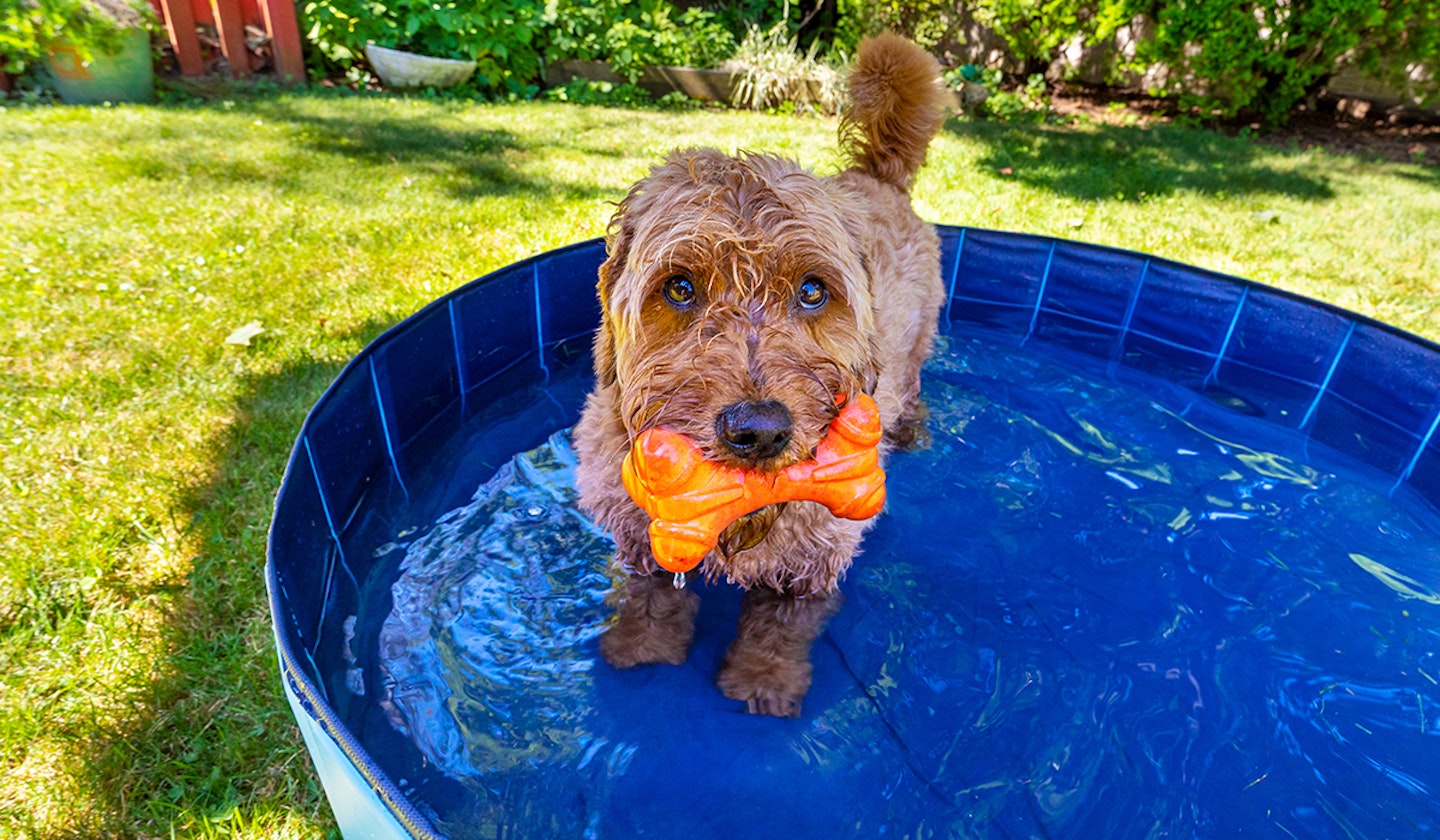Many humans look forward to the summer and a bout of (hopefully) warm weather, but for our dogs, it can be uncomfortable and potentially dangerous when the mercury rises. Whilst a nice stroll should be an essential part of their daily routine, it's crucial to be mindful of the temperatures to ensure their safety and avoid heatstroke, but when is it too hot to walk your dog?
We've followed guidance from the RSPCA and Dogs Trust, and have spoken to David Harris (BVSc PGCert VetEd FHEA MRCVS), Head of Veterinary Content at VetHelpDirect.com, who has given us all the information you need on how to cool down a dog.
When is it too hot to walk your dog?
There is no simple answer to this question, as dogs could potentially overheat even in winter. However, as a general rule, walking your dog at any temperature below 20°C is considered ideal, but need to be aware of the signs of heatstroke.
The RSCPA says: "It's not unusual for dogs to need vet care for heat-related illnesses after exercise. In fact, it affects 10 times more dogs than those overheating in cars."
Dogs don't sweat like humans do; they primarily cool themselves down through panting and, to a lesser extent, through their paw pads. This makes them more susceptible to overheating, especially on hot pavements.
Factors such as breed, age, health and coat type also play significant roles in a dog's heat tolerance. For instance, brachycephalic breeds like Bulldogs and Pugs, due to their short snouts, are particularly vulnerable to heat stroke.
It's recommended that you walk your dog either late and night or early in the morning, before the weather gets too hot, as this can help to minimise the risk of heatstroke. However, if the temperature is unbearably hot even
Dog walking temperature chart
If you're asking "is it too hot to walk my dog?" here is a helpful dog walking temperature chart, which can be used as a guide. It has been adapted from the TUFTS Animal Care and Condition (TACC) scales.

What happens to dogs paws in hot weather?
Your dogs paws can be just as sensitive as your feet. It's important to remember that most pavements are made out tarmac, which can get very hot (even in indirect sun) and can retain heat for long periods of time. If stepped on by a dog, it could burn their paws.
The five-second tarmac test
The Dogs Trust recommends doing the five-second tarmac test, where you check the temperature of the pavement before you let your dog walk on it. All you need to do is place your hand onto the tarmac for five seconds; if it's too hot for you, it is certainly too hot for you pooch's paws.
Which dogs may struggle the most during hot weather?
"In general, there are six groups of dogs who struggle most in hot weather", David tells us. These are:
Brachycephalic (short-nosed) dogs
Firstly, we have short-nosed, or brachycephalic, breeds such as Pugs, Bulldogs, and French Bulldogs. These dogs have been bred to look "cute", with big eyes and flat faces. Unfortunately, the result of this has been a narrowing of the airways and a profusion of soft tissue in the nasal chambers and pharynx - we call this Brachycephalic Airway Syndrome, and it profoundly affects their ability to pant and lose heat. Like a dog with any other respiratory disease, most members of these breeds are highly prone to heatstroke, and as they are often overweight as well, are at very high risk in hot weather.

Dogs with underlying health problems
Dogs with underlying health problems may struggle in hot and humid conditions. "Dogs can't sweat like we can, so rely largely on panting to cool down. However, if they have airway or lung impairments, or suffer from fluid balance or hydration issues, then this is more difficult, and their ability to lose heat is reduced, meaning they are at a higher risk of heat-stroke."
Overweight dogs
"Likewise, overweight animals find it harder to ventilate, and their core temperature rises faster than you'd expect for a lean dog."
Young and old dogs
"Very young dogs or very old dogs are also at increased risk of heatstroke, and these owners should be even more cautious in hot weather."
Dogs with thick coats
"Dogs with very thick coats, who are adapted to a colder climate. Dogs such as the Husky or Malamute - and even the Chow Chow - have been bred to keep heat in. However, this comes at the price of being less well able to cope in hot weather. Their thick double coats effectively trap heat, making it the equivalent of us going out in the July heat wearing a fur coat and thermal underwear: they get very hot, very quickly. This problem can be alleviated by clipping (NOT shaving)."
Signs of heatstroke in dogs
Here's the list of heatstroke symptoms from the RSPCA:
-
Heavy panting and difficulty breathing
-
Excessively drooling
-
The dog appears lethargic, drowsy or uncoordinated
-
Collapsed or vomiting
How to keep your dog cool
"Dog's don't just die in hot cars - they can die in the open air of heatstroke, especially if they're a high risk breed." says David.
Here are our top tips on how to keep dogs cool and hydrated during a heatwave, including advice from David Harris (BVSc PGCert VetEd FHEA MRCVS):
1. Always keep fresh water nearby - Avoid dehydration by providing access to clean drinking water. David recommends "adding ice to keep it cool".
2. Get a paddling pool - Dog-friendly paddling pools provide plenty of entertainment for your pooch and the water can cool them down. If you don't have room for a pool or your dog doesn't like them, try a sprinkler, splash pad or a dog cooling mat. You can also lightly mist your dog if they seem hot.

3. Never leave your dog in a hot car - This can cause heatstroke, even within a couple of minutes. David also says not to leave them in a "hot room" for prolonged periods of time (e.g. conservatories or rooms with no airflow). Set up a fan to keep rooms cool.
4. Keep them well-groomed - Thick fur is designed to trap heat, so dogs such as a husky, Malamute, and Chow Chow may need regular grooming to let the air get to their skin. However, "it's important to clip (NOT shave) their fur" says David. We recommend using dog grooming scissors which are specially designed to cut through their hair.
5. Make dog-friendly cold treats - Making ice lollies with dog-safe, natural ingredients (e.g.: meat/tuna, apples, raspberries, soaking kibble in water etc.) is a great way to keep them cool and hydrated. You can also buy these from certain retailers.

6. Avoid the sun and provide plenty of shade - David says, "Make sure your pet always has access to a cool shaded area, both indoors and outside". Closing curtains, using an umbrella/garden parasol or a cooling dog bed with a canopy are some great ways to create shade.
7. Don't over-exercise or walk your dog during high temperatures - Stay clear from the sun and wait until early morning or late at night (if it is cool enough). David says, "Remember, hot pavements can burn paws! If it’s too hot to hold your hand on, it’s too hot for your pet to walk on". Don't forget to take regular rests - especially if your dog is panting heavily or showing signs of overheating - and take a water bottle with you.
Remember, "Prevention always beats cure. If you think your dog is overheating, though, whatever their breed, there's one easy thing to remember - Wet Then Vet. Get cool or cold water onto them to cool them, and call your veterinarian as soon as possible for advice. Water immersion, or evaporative cooling, is the best way to rapidly cool down your dog. For young, healthy dogs, putting them straight into a cold-water bath is a good way to bring down their temperature fast. For older dogs, or for dogs with an underlying health condition, pouring over water of any temperature that is cooler than your dog is preferred. This should be combined with ‘evaporative cooling measures’ such as putting them in front of a fan or air conditioning unit."
Only when your dog has been actively cooled should you then take them on the journey to see the vet.
If you're worried about your dog, please speak to a veterinarian.
David Harris (BVSc PGCert VetEd FHEA MRCVS) is Head of Veterinary Content at VetHelpDirect.com.
Arabella Horspool is a Commercial Content Writer for Yours at Bauer Media. She's a bookworm who is passionate about TV and film. She enjoys cooking, scrapbooking and spending time with her three dogs, tortoise and chickens.
